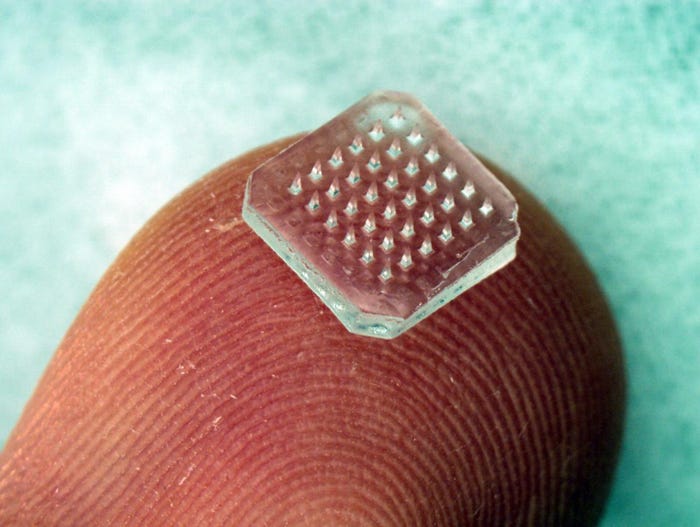Dissolving Microneedles Could Eliminate Use of Sharps, Spreading of Disease
July 23, 2010
|
Dissolvable microneedle arrays could be at the core of new vaccine-delivery technologies. |
Dissolving microneedles could enable safer and potentially more-effective vaccine-delivery systems, according to researchers at Georgia Tech (Atlanta) and Emory University (Atlanta). The scientists are currently testing the efficacy of microneedle vaccination in mice compared with traditional hypodermic needles.
Measuring 650 µm in length, the microneedles are designed into arrays constructed from the biocompatible polymer polyvinyl pyrrolidone. To create a complete delivery system, the researchers mounted an array composed of hundreds of vaccine-infused microneedles onto a water-soluble patch. Freeze-dried influenza vaccine, in this case, was mixed with a vinyl-pyrrolidone monomer prior to placing it in the microneedle mold and polymerizing at room temperature using UV light.
When the patch is applied to a subject, the microneedles penetrate the outer layer of skin and dissolve in body fluids to allow for vaccine delivery. The water-soluble backing is the only remaining component of the complete system. "The skin is a particularly attractive site for immunization because it contains an abundance of the types of cells that are important in generating immune responses to vaccines," states Richard Compans, professor of microbiology and immunology at Emory University School of Medicine.
The use of dissolvable microneedle-based systems instead of traditional hypodermic needles to deliver vaccines could offer several benefits, the researchers say. For example, the dissolvable nature of the polymer-based microneedles reduces waste and, more importantly, eliminates the use of sharps and the hazard they pose. The technology also prevents the opportunity for reuse of hypodermic needles, according to the scientists, which is credited as being a contributing factor to the spread of HIV and hepatitis B in impoverished areas. Microneedle-based systems could allow for self-administration of vaccines as well.
So far, the scientists' research has shown that microneedle-based systems are as effective, if not more so, than hypodermic needles in mice. However, more studies are necessary.
You May Also Like



